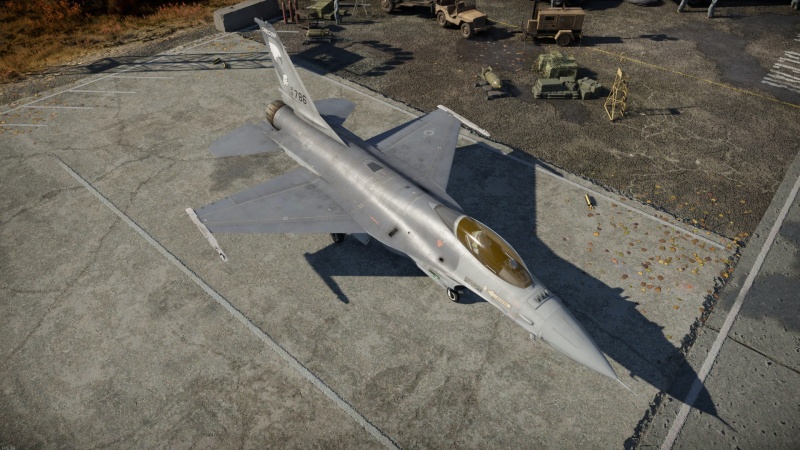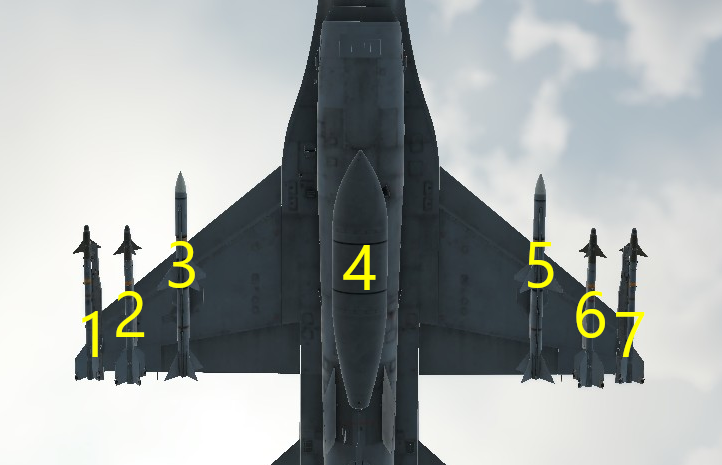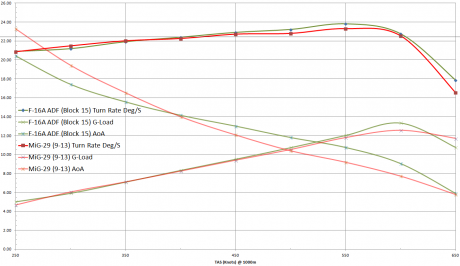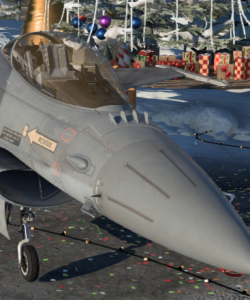Difference between revisions of "F-16A ADF"
(Updated description to new format) |
(→Description) |
||
| Line 11: | Line 11: | ||
== Description == | == Description == | ||
<!-- ''In the description, the first part should be about the history of and the creation and combat usage of the aircraft, as well as its key features. In the second part, tell the reader about the aircraft in the game. Insert a screenshot of the vehicle, so that if the novice player does not remember the vehicle by name, he will immediately understand what kind of vehicle the article is talking about.'' --> | <!-- ''In the description, the first part should be about the history of and the creation and combat usage of the aircraft, as well as its key features. In the second part, tell the reader about the aircraft in the game. Insert a screenshot of the vehicle, so that if the novice player does not remember the vehicle by name, he will immediately understand what kind of vehicle the article is talking about.'' --> | ||
| − | After the USAF Air Defense Command was dissolved, the Air National Guard (ANG) took up the task of defending American airspace in the mid-1980s. The F-16, which was introduced only several years prior, was selected, and 270 F-16A/B | + | After the USAF Air Defense Command was dissolved, the Air National Guard (ANG) took up the task of defending American airspace in the mid-1980s. The F-16, which was introduced only several years prior, was selected, and 270 F-16A/B airframes were converted to the ADF (Air Defense Fighter) standard. The first production variants of the F-16 lacked the ability to utilize the AIM-7 Sparrow, so the ADF included that feature. It also featured the AN/APX-109 IFF system and a spotlight for illumination during nighttime operations. Conversions were conducted at Ogden Air Logistics Center and carried on for 3 years. After the threat of Soviet bombers was over, many of the F-16 ADFs were either reconverted back into F-16A/Bs, placed into storage, or sold off to other countries. |
| + | |||
| + | Introduced in [[Update "Apex Predators"]], the '''{{Specs|name}}''' is a very powerful fighter thanks to its radar missile capability, dogfighting abilities, and overall performance. Firstly, the F-16A ADF is able to carry the [[AIM-7M Sparrow]], which is useful for medium to long-range engagements. The ADF can also equip all-aspect [[AIM-9L Sidewinder]]s, which have a decently long range for an infrared missile. Since the ADF was simply a conversion of the regular [[F-16A]] variant, it features the same engine and mostly the same airframe. However, the extra weight added by the various electronics and systems does increase the weight by around 280 kg (617 lb). Also, since the ADF was intended for interception, it lacks suspended armament and is mainly relegated to air duties. Nonetheless, the F-16A ADF is still overall an excellent aircraft. | ||
| − | |||
== General info == | == General info == | ||
=== Flight performance === | === Flight performance === | ||
| Line 182: | Line 183: | ||
In a dogfight, the F-16 will easily outperform a MiG-29 due to its superior low-speed handling. It should be noted that the F-16 can be a bit "floppy" at low speeds , and if not corrected, can lead to being shot down. | In a dogfight, the F-16 will easily outperform a MiG-29 due to its superior low-speed handling. It should be noted that the F-16 can be a bit "floppy" at low speeds , and if not corrected, can lead to being shot down. | ||
[[File:MiG-29 vs F-16A ADF performance (WT version 2.23.1.17).png|thumb|460x460px|F-16A ADF has excellent hidden sustain turn performance only available to those using sim controls due to the artificial G-limiter (which is actually just aggressive control stiffness/"compressibility") of the aircraft.]] | [[File:MiG-29 vs F-16A ADF performance (WT version 2.23.1.17).png|thumb|460x460px|F-16A ADF has excellent hidden sustain turn performance only available to those using sim controls due to the artificial G-limiter (which is actually just aggressive control stiffness/"compressibility") of the aircraft.]] | ||
| − | The MiG-29 at high altitude can be dangerous if the opponent utilizes [[R-27ER]]s. The R-27ER has superb range, acceleration, and manoeuvrability. To counter this, stay on the lookout for MiG-29s and R-27ERs and be prepared to go into a notch position and drop chaff. The R-27ER burns for 9 seconds which allows it to be spotted for a long time before the motor burns out. The F-16 will not be able to fight BVR against a MiG-29 unless it gets the jump/fires the missile far in advance. The R-27ER is a much quicker missile than the AIM-7M, and the R-27ER will reach its intended target much faster than the AIM-7M, even if launched at the same time. | + | The MiG-29 at high altitude can be dangerous if the opponent utilizes [[R-27ER]]s. The R-27ER has superb range, acceleration, and manoeuvrability. To counter this, stay on the lookout for MiG-29s and R-27ERs and be prepared to go into a notch position and drop chaff. The R-27ER burns for 9 seconds which allows it to be spotted for a long time before the motor burns out. The F-16 will not be able to fight BVR against a MiG-29 unless it gets the jump/fires the missile far in advance. The R-27ER is a much quicker missile than the AIM-7M, and the R-27ER will reach its intended target much faster than the AIM-7M, even if launched at the same time. |
=== Pros and cons === | === Pros and cons === | ||
Revision as of 09:29, 21 October 2023
| This page is about the American jet fighter F-16A ADF. For other versions, see F-16 (Family). |
Contents
Description
After the USAF Air Defense Command was dissolved, the Air National Guard (ANG) took up the task of defending American airspace in the mid-1980s. The F-16, which was introduced only several years prior, was selected, and 270 F-16A/B airframes were converted to the ADF (Air Defense Fighter) standard. The first production variants of the F-16 lacked the ability to utilize the AIM-7 Sparrow, so the ADF included that feature. It also featured the AN/APX-109 IFF system and a spotlight for illumination during nighttime operations. Conversions were conducted at Ogden Air Logistics Center and carried on for 3 years. After the threat of Soviet bombers was over, many of the F-16 ADFs were either reconverted back into F-16A/Bs, placed into storage, or sold off to other countries.
Introduced in Update "Apex Predators", the F-16A Block 15 ADF Fighting Falcon is a very powerful fighter thanks to its radar missile capability, dogfighting abilities, and overall performance. Firstly, the F-16A ADF is able to carry the AIM-7M Sparrow, which is useful for medium to long-range engagements. The ADF can also equip all-aspect AIM-9L Sidewinders, which have a decently long range for an infrared missile. Since the ADF was simply a conversion of the regular F-16A variant, it features the same engine and mostly the same airframe. However, the extra weight added by the various electronics and systems does increase the weight by around 280 kg (617 lb). Also, since the ADF was intended for interception, it lacks suspended armament and is mainly relegated to air duties. Nonetheless, the F-16A ADF is still overall an excellent aircraft.
General info
Flight performance
The F-16 ADF has a very poor manoeuvrability at higher speeds (above around 850 km/h) due to its angle of attack (AOA) limiter. Staying at these higher speeds is ideal for general air combat, but greatly limits your manoeuvring and dogfighting abilities. At these high speeds, poor nose-pointing ability makes it troublesome to lock Sidewinders, get an ACM radar lock, or aim the gun. Only by going below these speeds (thus getting slow) does any semblance of dogfighting ability whatsoever begin to be gained. The F-16's acceleration can be "too good": its poor high speed manoeuvrability combined with its excellent acceleration and energy retention means heavy down-throttling, air braking and energy management are practically required to drop below these speeds to be able to dogfight.
| Characteristics | Max speed (km/h at 10,973 m) |
Max altitude (metres) |
Turn time (seconds) |
Rate of climb (metres/second) |
Take-off run (metres) | |||
|---|---|---|---|---|---|---|---|---|
| AB | RB | AB | RB | AB | RB | |||
| Stock | 2,093 | 2,063 | 15240 | 20.3 | 20.6 | 252.7 | 240.2 | 850 |
| Upgraded | 2,198 | 2,146 | 19.3 | 19.8 | 340.8 | 295.0 | ||
Details
| Features | |||||
|---|---|---|---|---|---|
| Combat flaps | Take-off flaps | Landing flaps | Air brakes | Arrestor gear | Drogue chute |
| X | ✓ | ✓ | ✓ | ✓ | X |
| Limits | ||||||
|---|---|---|---|---|---|---|
| Wings (km/h) | Gear (km/h) | Flaps (km/h) | Max Static G | |||
| Combat | Take-off | Landing | + | - | ||
| 1,555 | 482 | N/A | 470 | 463 | ~10 | ~3 |
| Optimal velocities (km/h) | |||
|---|---|---|---|
| Ailerons | Rudder | Elevators | Radiator |
| < 680 | < 750 | < 700 | N/A |
Engine performance
| Engine | Aircraft mass | |||||
|---|---|---|---|---|---|---|
| Engine name | Number | Basic mass | Wing loading (full fuel) | |||
| Pratt & Whitney F100-PW-220 | 1 | 7,970 kg | 402 kg/m2 | |||
| Engine characteristics | Mass with internal fuel (no weapons load) | Max Gross Weight | ||||
| Weight (each) | Type | 8m fuel | 20m fuel | 29m fuel | ||
| 1,470 kg | Afterburning low-bypass turbofan | 8,942 kg | 10,193 kg | 11,210 kg | 12,914 kg | |
| Maximum engine thrust @ 0 m (RB/SB) | Thrust to weight ratio @ 0 m (WEP) | |||||
| Condition | 100% | WEP | 8m fuel | 20m fuel | 29m fuel | MGW |
| Stationary | 6,490 kgf | 8,985 kgf | 1.01 | 0.88 | 0.80 | 0.70 |
| Optimal | 7,434 kgf (1,555 km/h) |
15,225 kgf (1,400 km/h) |
1.71 | 1.49 | 1.36 | 1.18 |
Survivability and armour
Examine the survivability of the aircraft. Note how vulnerable the structure is and how secure the pilot is, whether the fuel tanks are armoured, etc. Describe the armour, if there is any, and also mention the vulnerability of other critical aircraft systems.
Modifications and economy
Armaments
| Ballistic Computer | ||||
|---|---|---|---|---|
| CCIP (Guns) | CCIP (Rockets) | CCIP (Bombs) | CCRP (Bombs) | Lead indicator |
| |
|
|
|
|
Offensive armament
The F-16A ADF is armed with:
- A choice between two presets:
- 1 x 20 mm M61A1 cannon, wing root-mounted (512 rpg)
- 1 x 20 mm M61A1 cannon + 60 x countermeasures
Suspended armament
The F-16A ADF can be outfitted with the following ordnance presets:
- 1 x 300 gal drop tank
- 2 x AIM-9L Sidewinder missiles
- 6 x AIM-9L Sidewinder missiles
- 2 x AIM-7M Sparrow missiles
Custom loadout options
| 1 | 2 | 3 | 4 | 5 | 6 | 7 | ||
|---|---|---|---|---|---|---|---|---|
| AIM-7M Sparrow missiles | 1 | 1 | ||||||
| AIM-9L Sidewinder missiles | 1 | 1 | 1 | 1 | 1 | 1 | ||
| 300 gal drop tanks | 1 |
Usage in battles
The F-16A ADF can be a powerful fighter with multiple playstyles, rushing straight into battle or hanging high and utilizing the AIM-7M Sparrows. Players that plan to stay low and accelerate straight into action will be satisfied with the F-16's low-altitude performance and radar. Players that want to keep high and sling AIM-7Ms at targets will be more than pleased with the F-16's strong climb rate, range of the AIM-7M, and radar. A mixed countermeasure loadout (1 flare, 1 chaff) is recommended because it allows 30 countermeasure drops against radar or IR missiles. In order to be prepared for matches that may extend longer than usual, select the 20-minute fuel option in conjunction with the 300-gallon drop tank. The F-16 consumes a lot of fuel on afterburner, so it's essential to use it wisely unless the max fuel amount is selected.
The AIM-7Ms must be used wisely since only 2 Sparrows can be carried simultaneously. For long-range, high-altitude fights, seek out targets closing in fast. Do not fire at targets already about to notch or beginning to notch. AIM-7Ms are excellent for these types of engagements due to their range and manoeuvrability. As for low-altitude engagements, look for targets closing in fast and at around 500 metres altitude or above. Do not fire at targets that are flying very close to the ground because the radar will track underneath the intended target, and the missile will miss. As for AIM-9L Sidewinders, players can be more generous with them since the ADF can carry up to 6 AIM-9Ls. If a player finds themselves above the fight, it will be effortless to fire off missiles at distracted enemies and score kills quickly. AIM-9Ls are very strong from the rear aspect and require hard defending from the opponent to evade successfully.
The F-16 is very strong in a dogfight due to its excellent TWR and energy retention. Before entering a dogfight, however, it's critical to be at the correct speed. The F-16 has a very wide turning circle at high speeds, so make sure to stay around 800-850 km/h (497-528 mph) when entering a dogfight.
Countering the MiG-29
The MiG-29 is a very versatile and capable fighter and will be one of the most common enemies you will face. However, like many planes, it's possible to counter it. It's one of the fastest jets on the deck (~1,550 km/h, 963 mph) and has access to a helmet-mounted sight, which allows the player to lock the missile in the direction of the pilot's view rather than just along the nose of the aircraft. This allows for off-bore missile launches which can be a threat. It's important to be on the lookout all the time for any missile launches, whether it be an R-60M or an R-27T.
In a dogfight, the F-16 will easily outperform a MiG-29 due to its superior low-speed handling. It should be noted that the F-16 can be a bit "floppy" at low speeds , and if not corrected, can lead to being shot down.
The MiG-29 at high altitude can be dangerous if the opponent utilizes R-27ERs. The R-27ER has superb range, acceleration, and manoeuvrability. To counter this, stay on the lookout for MiG-29s and R-27ERs and be prepared to go into a notch position and drop chaff. The R-27ER burns for 9 seconds which allows it to be spotted for a long time before the motor burns out. The F-16 will not be able to fight BVR against a MiG-29 unless it gets the jump/fires the missile far in advance. The R-27ER is a much quicker missile than the AIM-7M, and the R-27ER will reach its intended target much faster than the AIM-7M, even if launched at the same time.
Pros and cons
Pros:
- Excellent acceleration and climb rate, the former of which helps the F-16 recover from the lower speeds that it can dogfight at
- Excellent energy retention
- Excellent manoeuvrability at low to medium speeds
- Decent top speed
- 20 mm Vulcan cannon has high velocity and rate of fire
- Six powerful missiles: up to six all aspect AIM-9Ls and up to two potent SARH AIM-7Ms
- Drop tank available to extend range
- Bubble canopy with excellent unobstructed 360° visibility gives great situational awareness in simulator mode
Cons:
- Lacks any air-to-ground suspended ordnance whatsoever
- Internal M61 cannon has a small ammo pool
- Very poor manoeuvrability at higher speeds (above around 850 km/h), greatly limiting its manoeuvring and dogfighting ability
- Very hot engine temperature
- Extremely high fuel consumption on afterburner
History
In the mid-1980s, after the deactivation of the USAF Air Defense Command, the ANG (Air National Guard) was tasked with defending North American airspace from Soviet bombers. To complete this task, 270 F-16A/Bs were to be converted into ADFs (Air Defense Fighters) at Ogden Air Logistics Center in Utah. General Dynamics carried out the first conversions and then sent kits to Ogden to complete the conversion. The ADF conversion included upgrading the AN/APG-66 radar to improve target acquisition of small targets, IFF for distinguishing friendlies and foes (AN/APX-109), and a 150,000-candlepower night spotlight for identification.
The first F-16 ADF was delivered to the Oregon Air National Guard in March 1989. Conversions started from 1989 to 1992, with around 270 airframes converted to ADF F-16s. However, with the dissolution of the Soviet Union, there was no longer a purpose for the F-16 ADF. The Air National Guard F-16s were to be slowly phased out and were either converted back to the original F-16A/B configuration or placed in storage. The North Dakota ANG had the last few F-16 ADFs in service until they were retired in 2007. Since the F-16 ADFs in storage had low flight hours, they were sold to other countries like Jordan (Peace Falcon program) and Thailand (Peace Naresuan IV program.)
Media
- Skins
- Images
See also
- Related development
External links
Paste links to sources and external resources, such as:
- topic on the official game forum;
- other literature.
| General Dynamics Corporation | |
|---|---|
| Jet Fighters | F-16A · F-16A ADF · F-16C |
| Strike Aircraft | F-111A · F-111F |
| Export | ▄F-16A ADF · ▄F-16A · ▄F-16AM · ␗F-16A MLU · F-16AJ · Netz · F-16D Barak II · F-16C Barak II |
| F-111C | |
| See also | SABCA |
| USA jet aircraft | |
|---|---|
| Fighters | |
| F-4 | F-4C Phantom II · F-4E Phantom II · F-4J Phantom II · F-4S Phantom II |
| F-5 | F-5A · F-5C · F-5E · F-20A |
| F-8 | F8U-2 · F-8E |
| F-80 | F-80A-5 · F-80C-10 |
| F-84 | F-84B-26 · F-84F · F-84G-21-RE |
| F-86 | F-86A-5 · F-86F-25 · F-86F-2 · F-86F-35 |
| F-89 | F-89B · F-89D |
| F-100 | F-100D |
| F-104 | F-104A · F-104C |
| F-14 | F-14A Early · F-14B |
| F-15 | F-15A · F-15C MSIP II |
| F-16 | F-16A · F-16A ADF · F-16C |
| F9F | F9F-2 · F9F-5 · F9F-8 |
| Other | P-59A · F2H-2 · F3D-1 · F3H-2 · F4D-1 · F11F-1 |
| Strike Aircraft | |
| FJ-4 | FJ-4B · FJ-4B VMF-232 |
| A-4 | A-4B · A-4E Early |
| A-6 | A-6E TRAM |
| A-7 | A-7D · A-7E · A-7K |
| AV-8 | AV-8A · AV-8C · AV-8B Plus · AV-8B (NA) |
| A-10 | A-10A · A-10A Late · A-10C |
| B-57 | B-57A · B-57B |
| F-105 | F-105D |
| F-111 | F-111A · F-111F |








